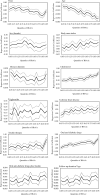Factors affecting Hemoglobin A1c in the longitudinal study of the Iranian population using mixed quantile regression
- PMID: 37308493
- PMCID: PMC10260964
- DOI: 10.1038/s41598-023-36481-x
Factors affecting Hemoglobin A1c in the longitudinal study of the Iranian population using mixed quantile regression
Abstract
Diabetes, a major non-communicable disease, presents challenges for healthcare systems worldwide. Traditional regression models focus on mean effects, but factors can impact the entire distribution of responses over time. Linear mixed quantile regression models (LQMMs) address this issue. A study involving 2791 diabetic patients in Iran explored the relationship between Hemoglobin A1c (HbA1c) levels and factors such as age, sex, body mass index (BMI), disease duration, cholesterol, triglycerides, ischemic heart disease, and treatments (insulin, oral anti-diabetic drugs, and combination). LQMM analysis examined the association between HbA1c and the explanatory variables. Associations between cholesterol, triglycerides, ischemic heart disease (IHD), insulin, oral anti-diabetic drugs (OADs), a combination of OADs and insulin, and HbA1c levels exhibited varying degrees of correlation across all quantiles (p < 0.05), demonstrating a positive effect. While BMI did not display significant effects in the lower quantiles (p > 0.05), it was found to be significant in the higher quantiles (p < 0.05). The impact of disease duration differed between the low and high quantiles (specifically at the quantiles of 5, 50, and 75; p < 0.05). Age was discovered to have an association with HbA1c in the higher quantiles (specifically at the quantiles of 50, 75, and 95; p < 0.05). The findings reveal important associations and shed light on how these relationships may vary across different quantiles and over time. These insights can serve as guidance for devising effective strategies to manage and monitor HbA1c levels.
© 2023. The Author(s).
Conflict of interest statement
The authors declare no competing interests.
Figures



Similar articles
-
[Associations between glycated hemoglobin levels and atherosclerotic risk factors in urban communities].Nihon Koshu Eisei Zasshi. 2002 Aug;49(8):729-38. Nihon Koshu Eisei Zasshi. 2002. PMID: 12355867 Japanese.
-
More schooling is associated with lower hemoglobin A1c at the high-risk tail of the distribution: an unconditional quantile regression analysis.BMC Public Health. 2025 Jun 3;25(1):2062. doi: 10.1186/s12889-025-23063-x. BMC Public Health. 2025. PMID: 40462031 Free PMC article.
-
C-peptide and its correlation to parameters of insulin resistance in the metabolic syndrome.CNS Neurol Disord Drug Targets. 2011 Dec;10(8):921-7. doi: 10.2174/187152711799219271. CNS Neurol Disord Drug Targets. 2011. PMID: 22229322
-
Age, gender, insulin and blood glucose control status alter the risk of ischemic heart disease and stroke among elderly diabetic patients.Cardiovasc Diabetol. 2011 Oct 6;10:86. doi: 10.1186/1475-2840-10-86. Cardiovasc Diabetol. 2011. PMID: 21978180 Free PMC article. Clinical Trial.
-
Associations of body mass index with glycated albumin and glycated albumin/glycated hemoglobin A1c ratio in Chinese diabetic and non-diabetic populations.Clin Chim Acta. 2018 Sep;484:117-121. doi: 10.1016/j.cca.2018.05.044. Epub 2018 May 24. Clin Chim Acta. 2018. PMID: 29802831
References
-
- International Diabetes Federation. IDF Diabetes Atlas, 9th edn. Brussels: International Diabetes Federation, 2019. https://diabetesatlas.org/en/sections/worldwide-toll-of-diabetes.html. Accessed 17 Oct 2021.
-
- Abrishami Z, Nasli-Esfahani E, Razmandeh R, Larijani B, Bandarian F. Iran diabetes research roadmap (IDRR) study; gap analysis of diabetes complications in Iran: A review article. Iran. J. Public Health. 2017;46:32–38.
MeSH terms
Substances
LinkOut - more resources
Full Text Sources
Medical

